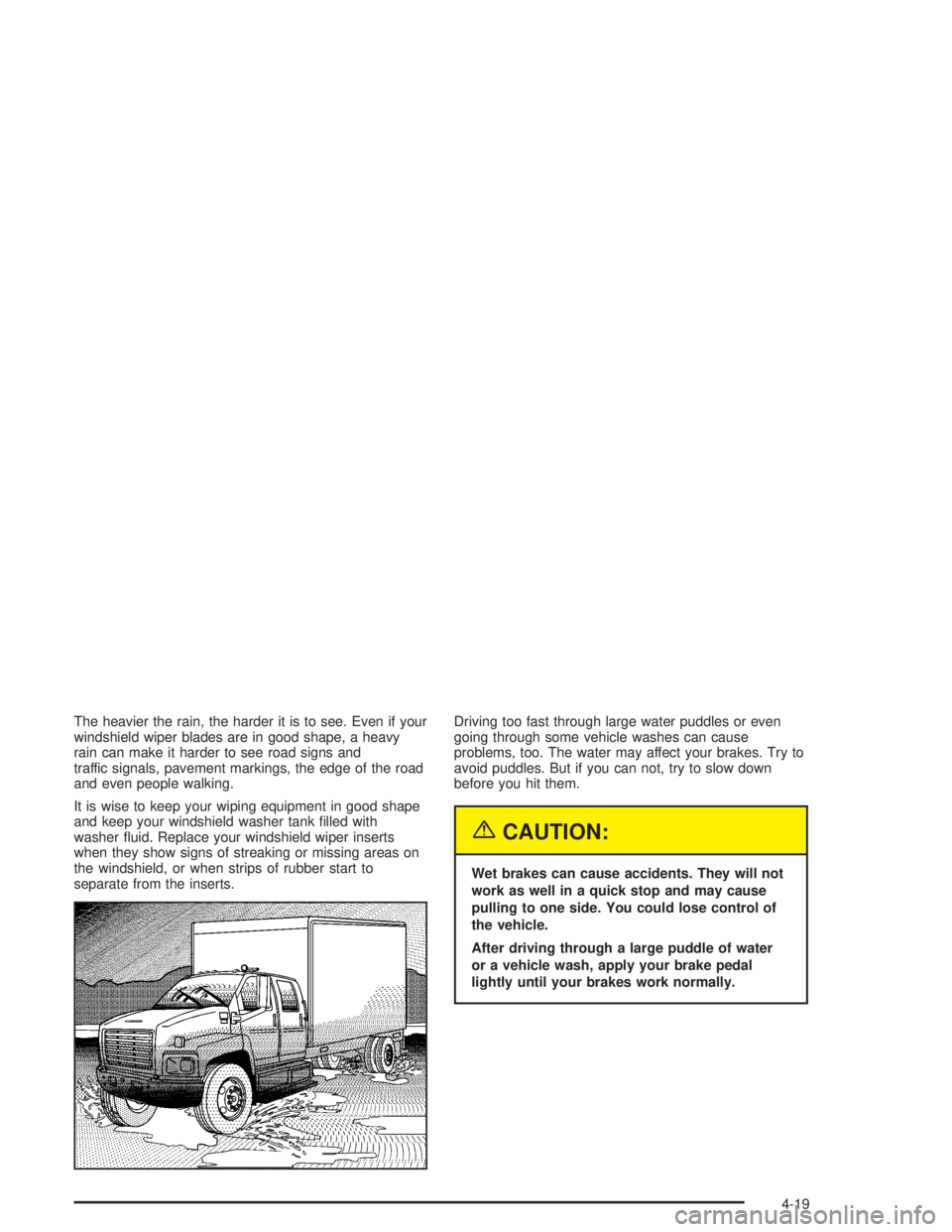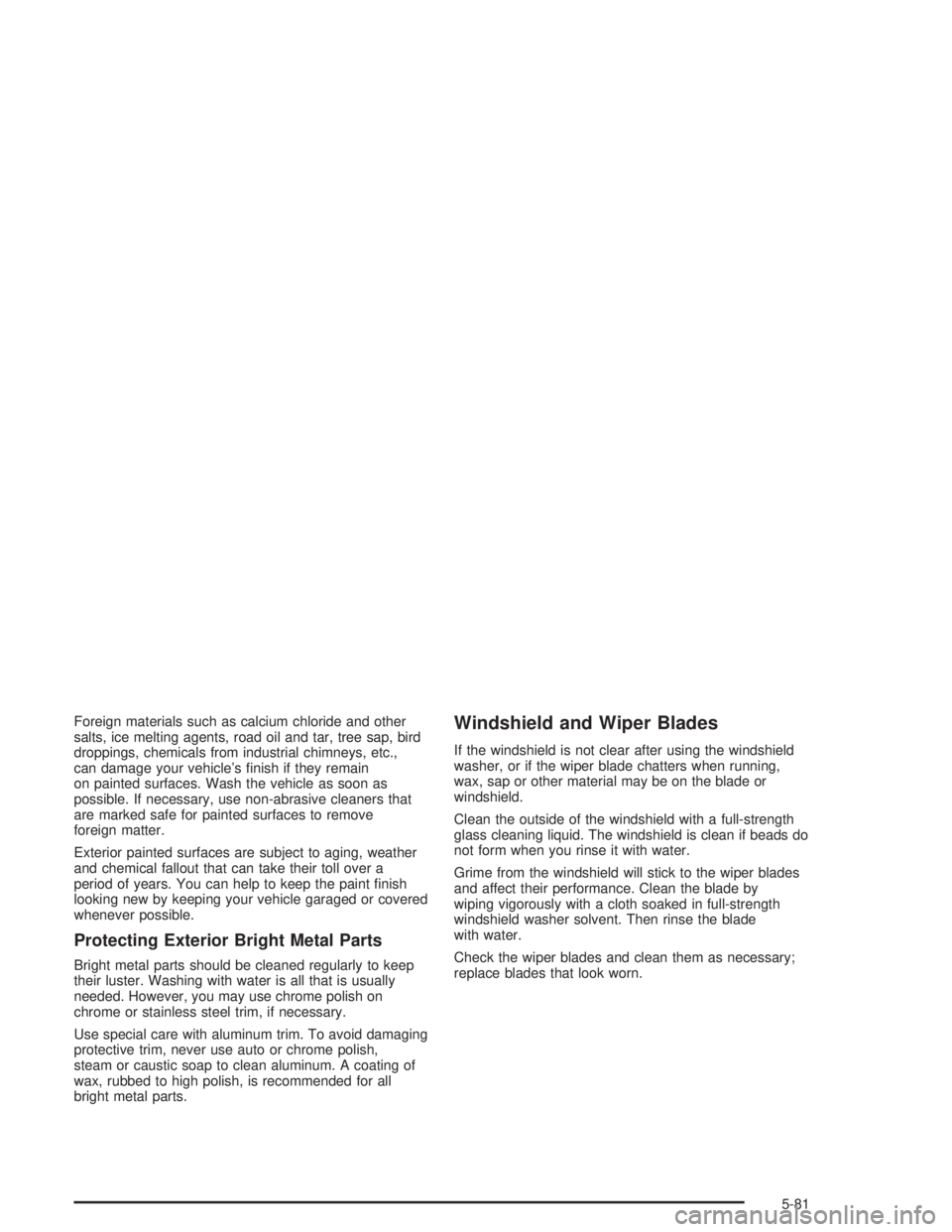2004 CHEVROLET KODIAK wiper blades
[x] Cancel search: wiper bladesPage 119 of 366

8(Mist):For a single wiping cycle, turn the band to
this symbol. Hold it there until the wipers start, then
let go. The wipers will stop after one cycle. If you want
more cycles, hold the band on mist longer.
You can set the wiper speed for a long or short delay
between wipes. This can be very useful in light rain
or snow. Turn the band to one of the four delay settings
to choose the delay time. The further the band is
turned upward, the longer the delay will be. The further
the band is turned downward, the shorter the delay
will be.
6(Low Speed):For steady wiping at low speed,
turn the band toward you to the first solid band
below the delay settings.
1(High Speed):For high-speed wiping, turn the
band further, to the second solid band below the delay
settings. To stop the wipers, move the band to off.
Be sure to clear ice and snow from the wiper blades
before using them. If they are frozen to the windshield,
carefully loosen or thaw them. If your blades do
become worn or damaged, get new blades or blade
inserts. For more information, seeWindshield Wiper
Blade Replacement on page 5-63.Heavy snow or ice can overload your wipers. The
windshield wiper motor is protected from overload by a
circuit breaker and a fuse. If the motor overheats
due to heavy snow or ice the wiper will stop until the
motor cools. Although the circuit is protected from
electrical overload, overload due to heavy snow or ice
may cause wiper linkage damage. Always clear ice and
heavy snow from the windshield before using your
windshield wipers.
Windshield Washer
L
(Washer Fluid):There is a paddle marked with the
windshield washer symbol at the top of the multifunction
lever. To spray washer fluid on the windshield, press
the paddle. The wipers will clear the window and
then either stop or return to your preset speed.
{CAUTION:
In freezing weather, do not use your washer
until the windshield is warmed. Otherwise the
washer �uid can form ice on the windshield,
blocking your vision.
3-9
Page 189 of 366

The heavier the rain, the harder it is to see. Even if your
windshield wiper blades are in good shape, a heavy
rain can make it harder to see road signs and
traffic signals, pavement markings, the edge of the road
and even people walking.
It is wise to keep your wiping equipment in good shape
and keep your windshield washer tank filled with
washer fluid. Replace your windshield wiper inserts
when they show signs of streaking or missing areas on
the windshield, or when strips of rubber start to
separate from the inserts.Driving too fast through large water puddles or even
going through some vehicle washes can cause
problems, too. The water may affect your brakes. Try to
avoid puddles. But if you can not, try to slow down
before you hit them.
{CAUTION:
Wet brakes can cause accidents. They will not
work as well in a quick stop and may cause
pulling to one side. You could lose control of
the vehicle.
After driving through a large puddle of water
or a vehicle wash, apply your brake pedal
lightly until your brakes work normally.
4-19
Page 269 of 366

Bulb Replacement
Replacement Bulbs
It is recommended that you use an ACDelco®type bulb
whenever you need to replace one.
If you need a bulb replaced, contact your dealer.
Windshield Wiper Blade
Replacement
Windshield wiper blades should be inspected at least
twice a year for wear or cracking. SeeWiper Blade
CheckunderAt Least Twice a Year on page 6-25for
more information.
Replacement blades come in different types and are
removed in different ways.Here’s how to remove the Shephard’s Hook type:
1. Pull the windshield wiper arm away from the
windshield.
5-63
Page 287 of 366

Foreign materials such as calcium chloride and other
salts, ice melting agents, road oil and tar, tree sap, bird
droppings, chemicals from industrial chimneys, etc.,
can damage your vehicle’s finish if they remain
on painted surfaces. Wash the vehicle as soon as
possible. If necessary, use non-abrasive cleaners that
are marked safe for painted surfaces to remove
foreign matter.
Exterior painted surfaces are subject to aging, weather
and chemical fallout that can take their toll over a
period of years. You can help to keep the paint finish
looking new by keeping your vehicle garaged or covered
whenever possible.
Protecting Exterior Bright Metal Parts
Bright metal parts should be cleaned regularly to keep
their luster. Washing with water is all that is usually
needed. However, you may use chrome polish on
chrome or stainless steel trim, if necessary.
Use special care with aluminum trim. To avoid damaging
protective trim, never use auto or chrome polish,
steam or caustic soap to clean aluminum. A coating of
wax, rubbed to high polish, is recommended for all
bright metal parts.
Windshield and Wiper Blades
If the windshield is not clear after using the windshield
washer, or if the wiper blade chatters when running,
wax, sap or other material may be on the blade or
windshield.
Clean the outside of the windshield with a full-strength
glass cleaning liquid. The windshield is clean if beads do
not form when you rinse it with water.
Grime from the windshield will stick to the wiper blades
and affect their performance. Clean the blade by
wiping vigorously with a cloth soaked in full-strength
windshield washer solvent. Then rinse the blade
with water.
Check the wiper blades and clean them as necessary;
replace blades that look worn.
5-81
Page 335 of 366

At Least Twice a Year
Restraint System Check
Make sure the safety belt reminder light (if equipped)
and all your belts, buckles, latch plates, retractors
and anchorages are working properly. Look for any other
loose or damaged safety belt system parts. If you see
anything that might keep a safety belt system from doing
its job, have it repaired. Have any torn or frayed
safety belts replaced.
Wiper Blade Check
Inspect wiper blades for wear or cracking. Replace
blade inserts that appear worn or damaged or that
streak or miss areas of the windshield. Also see
Cleaning the Outside of Your Vehicle on page 5-80.
Weatherstrip Lubrication
Silicone grease on weatherstrips will make them last
longer, seal better, and not stick or squeak. Apply
silicone grease with a clean cloth. During very cold,
damp weather more frequent application may be
required. Part C tells you what to use.
Body Lubrication Service
Lubricate all exposed surfaces such as door checks,
door lock bolts, lock strike plates, door hinge bushings,
latches and dovetail bumper wedges. Where oil
holes are provided a dripless oil can be used. The seat
adjusters, seat track, door weatherstrips and rubber
cap bumpers should also be lubricated. Part C tells you
what to use. More frequent lubrication may be required
when exposed to a corrosive environment.
Parking Brake Check
Park on a fairly steep hill and hold the vehicle with the
parking brake only. This checks holding ability.
6-25
Page 337 of 366

Exhaust System Check
Be alert for any changes in the sound of the exhaust
system or any smell of fumes. These are signs the
system may be leaking. Have it checked and/or repaired
at once. Refer toEngine Exhaust on page 2-37and
Running Your Engine While You Are Parked on
page 2-38.
Windshield Wipers and Washers Check
Check operation and condition of the wiper blades.
Check the flow of the washer spray.
Defroster Check
Move the control to the defrost symbol and the fan to HI
or the high symbol. Then check the airflow from the
ducts at the inside base of the windshield.
Mirrors and Sun Visors Check
Check that friction joints hold mirrors and sun visors in
place.
Seat Adjuster Check
When adjusting a manual seat, be sure seat adjusters
latch by attempting to move the seat after latching.
Lamps Check
Check panel lighting, warning lights, indicator lights and
interior lamps. On the outside, check: license plate
lamps, sidemarker lamps, reflectors or lights on outside
mirrors, headlamps, parking lamps, identification and
clearance lamps, taillamps, brake lamps, turn signals,
backup lamps and hazard warning flashers. Have
headlamp aim checked at once if beams seem
improperly aimed.
Glass, Mirrors, Lamps and/or
Re�ectors Condition Check
Look for broken, scratched, dirty or damaged glass,
mirrors, lamps or reflectors that could reduce the view
or visibility or cause injury. Replace, clean or repair
promptly.
Door Latches Check
Check that doors close, latch and lock tightly. Check for
broken, damaged or missing parts that might prevent
tight latching.
6-27
Page 366 of 366

When to Check and Change Fluid.....................5-61
When to Check and Change Lubricant...............5-61
When to Inspect the Engine Air
Cleaner/Filter..............................................5-30
Where to Put the Restraint.......................1-35, 1-37
Why Safety Belts Work..................................... 1-9
Windows......................................................... 2-8
Manual........................................................ 2-8
Power......................................................... 2-9
Sliding Rear................................................2-10
Windshield and Wiper Blades...........................5-81
Windshield Washer........................................... 3-9
Fluid..........................................................5-44
Windshield Washer Fluid Level Check................6-24Windshield Wiper
Blade Replacement......................................5-63
Fuses........................................................5-87
Windshield Wipers............................................ 3-8
Windshield Wipers and Washers Check.............6-27
Winter Driving................................................4-25
Wiper Blade Check.........................................6-25
Y
Your Vehicle and the Environment....................... 6-2
Z
ZF Six-Speed Transmission..............................2-31
16